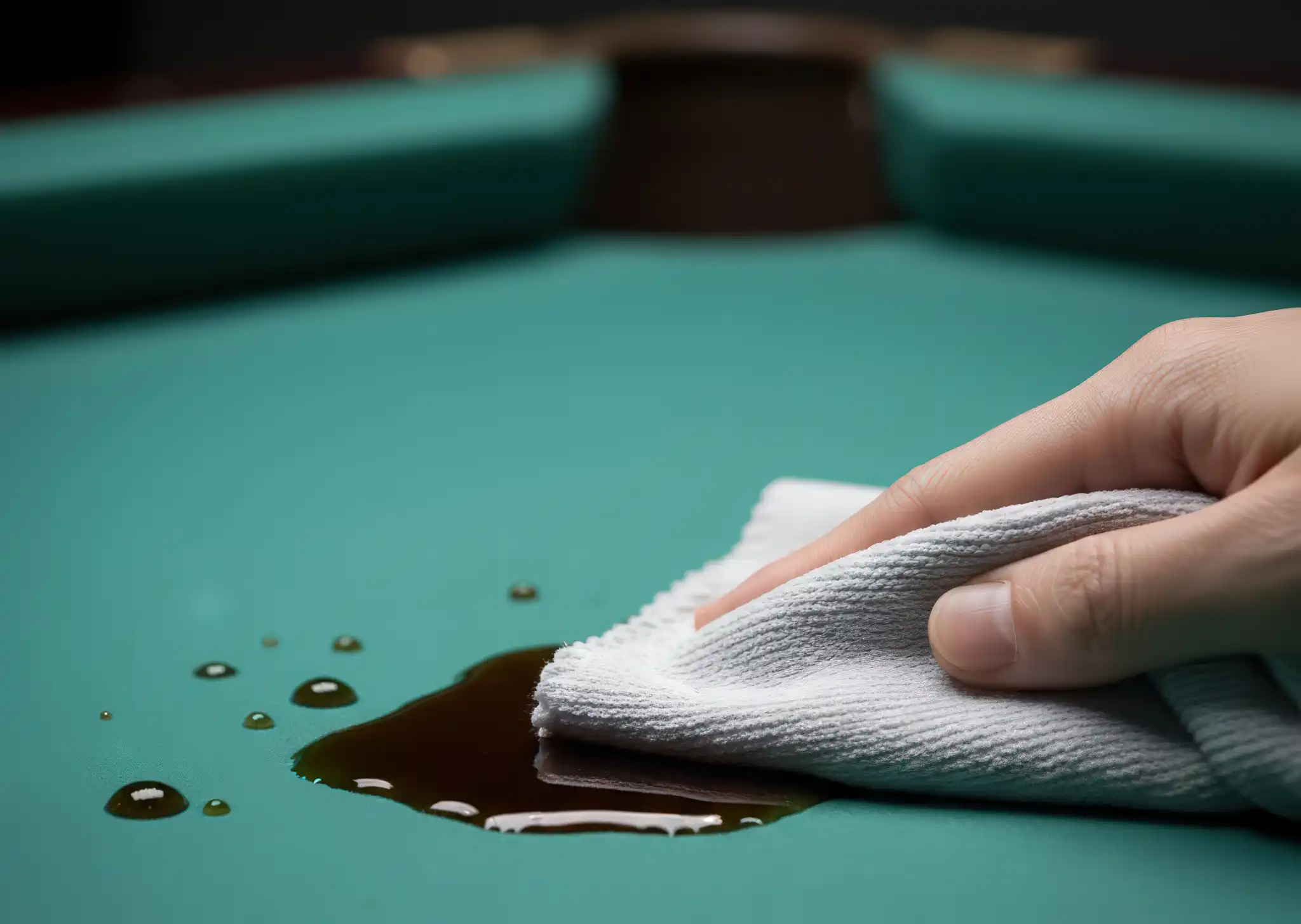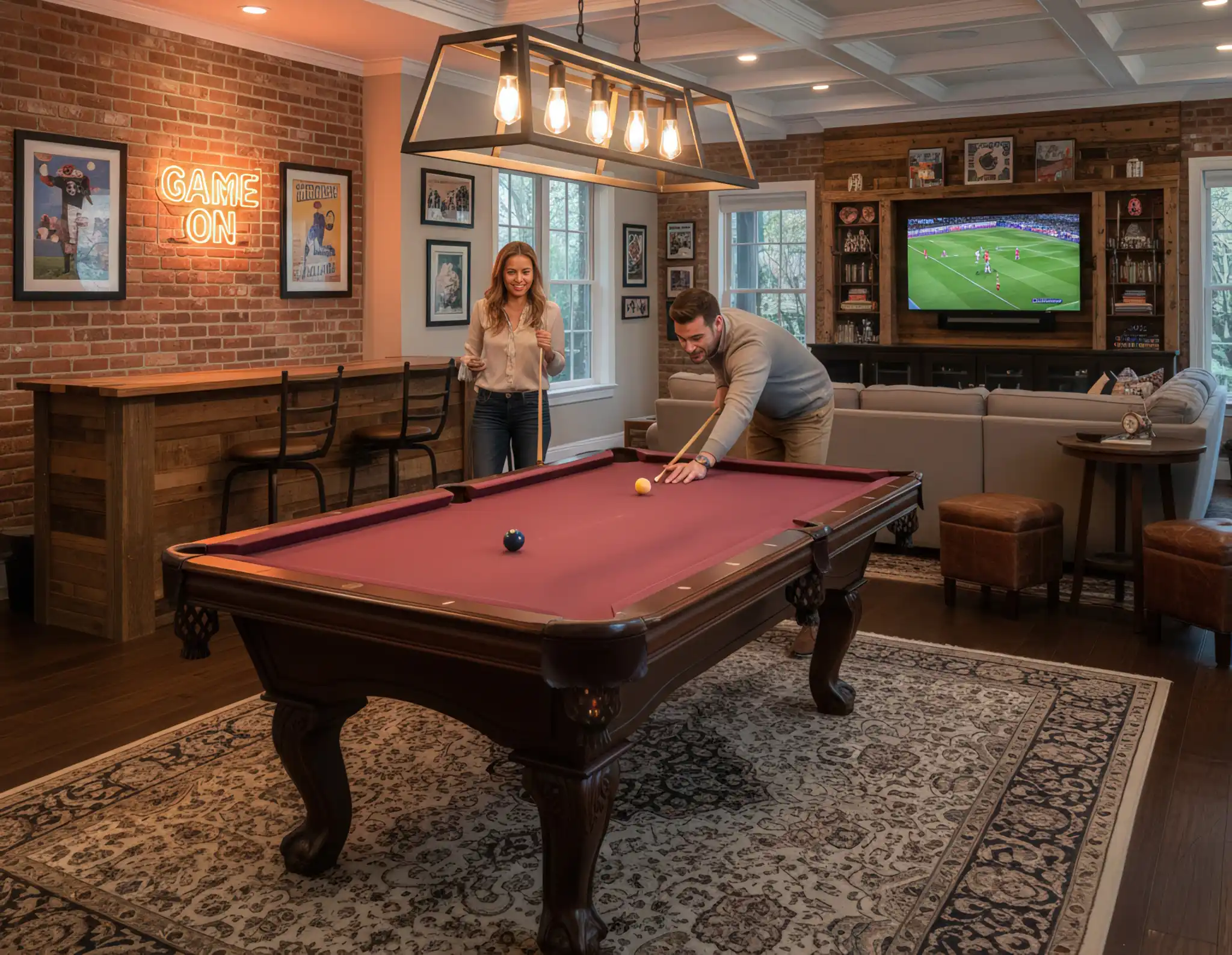Your pool table is the centerpiece of your game room, a significant investment in years of entertainment and friendly competition. The quality of your game, however, depends entirely on the quality of your playing surface. The felt, or more accurately, the billiard cloth, is the most critical and delicate component. Proper care is essential not just for aesthetics, but to ensure a true, consistent ball roll and to dramatically extend the life of your table. Many owners are unsure how to maintain pool table felt properly, leading to premature wear, damage, and costly replacements. This guide provides a complete maintenance plan for pool table owners in the GTA, covering everything from daily care to professional tips to keep your table in tournament-ready condition.
Key Takeaways
- Knowing your felt type, either worsted wool (like Simonis) or napped woolen, is critical as they require different cleaning techniques.
- A consistent care schedule—wiping down after play, brushing weekly, and vacuuming monthly—is the most effective way to prevent long-term damage.
- The physics of ball burns involves intense friction and heat; using high-quality phenolic resin balls can significantly minimize these marks.
- Always blot spills immediately with a microfiber cloth; never rub, as this will spread the stain and damage the felt fibers.
- For significant damage, deep stains, or a loss of playability, calling a professional for refelting is an investment in restoring your table’s performance.
Understanding Your Playing Surface: Not All Felt is Created Equal
Before you can properly maintain your pool table felt, you need to know what you’re working with. The term “felt” is a catch-all, but high-quality tables use sophisticated billiard cloth made from wool, and the two primary types behave very differently.
Worsted Wool vs. Napped Woolen Felt: What’s the Difference?
| Feature | Worsted Wool (e.g., Simonis) | Napped Woolen Felt |
| Texture | Smooth, flat, tightly woven surface with no fuzz. | Fuzzy, thick texture with a distinct directional nap. |
| Material | Wool fibers are combed straight before weaving. | Wool fibers are not combed, creating a fuzzy surface. |
| Play Speed | Fast and consistent ball roll with high accuracy. | Slower ball roll due to higher friction. |
| Durability | Extremely durable and resistant to pilling and burns. | Less durable; prone to pilling and showing wear. |
| Best For | Professional tournaments and serious players. | Home, recreational, and coin-operated tables. |
Why Knowing Your Felt Type Matters for Cleaning
Your cleaning method must match your cloth type. Brushing a napped woolen cloth in the direction of the nap smooths it down, ensuring proper play. Brushing a worsted cloth, like the industry-leading Simonis cloth, however, is simply about removing chalk dust and debris from the surface. Using the wrong technique, especially an aggressive one, can damage the weave of worsted cloth or disrupt the nap of woolen felt, permanently affecting ball roll.
Your Essential Felt Maintenance Toolkit (What You Actually Need)
You don’t need an arsenal of expensive products to maintain your felt. A few high-quality tools will protect your investment and keep your table playing perfectly for years.
The Must-Haves: The Right Brush, Microfiber Cloths, and a Cover
The single most important tool is a purpose-made pool table brush. Look for one with horsehair bristles, which are soft enough not to damage the fibers but firm enough to effectively remove dust and chalk. You will also need a stack of clean, dry microfiber cloths for wiping balls and addressing spills. Finally, a high-quality pool table cover is non-negotiable. It protects your felt from dust, sunlight, and accidental spills when not in use.
The Nice-to-Haves: Specialized Felt Cleaner vs. DIY Solutions
For occasional deep cleaning or stubborn stains, a specialized felt cleaner can be useful. These are formulated to lift dirt without oversaturating or damaging the cloth. For minor dust and debris, some players use a lint roller, but this should be done with a very light touch. A vacuum with a non-rotating brush attachment can also be used for monthly deep cleaning.
Investing in Your Tools: The Cost of a Good Kit vs. the Cost of Neglect
A quality brush might cost between $20-$40, and a good cover can range from $50 to over $150. This initial investment of around $200 is minimal compared to the alternative. Professional refelting services in the GTA can cost anywhere from $500 to over $1,000, depending on the table and cloth quality. Proper maintenance is the most cost-effective decision you can make.
The Simple Pool Table Felt Care Schedule (Daily, Weekly, Monthly)
Consistency is the key to effective pool table cloth care. By integrating these simple steps into a regular schedule, you can prevent the buildup of grime and chalk that degrades the playing surface over time.
| Frequency | Task | Description |
| Daily (After Play) | 2-Minute Wipe Down | Wipe the cue ball and object balls with a microfiber cloth to remove chalk and oils. Replace the table cover. |
| Weekly | Essential Brushing | Brush the entire felt surface in one direction (head to foot) to collect dust and debris. |
| Monthly | Deep Clean | After brushing, gently vacuum the felt with a non-rotating upholstery attachment. Wipe down rails and pockets. |
The Correct Way to Brush (And Why It Matters)
Always brush in one direction. This is crucial for both napped and worsted cloths. On napped felt, this smooths the fibers down, maintaining the intended direction of the nap. On worsted cloth, brushing in straight lines prevents you from simply pushing dust around and helps lift it from the weave, protecting the cloth’s integrity and ensuring a true roll.

How to Vacuum Without Damaging Your Felt
Never use a vacuum with a spinning beater bar, as it will aggressively pull, stretch, and potentially tear the cloth. The goal is to gently lift chalk dust and fine debris, not to deep clean a carpet. Keep the vacuum moving and use light pressure to avoid creating any suction marks on the surface.
Emergency Response: How to Tackle Spills and Stains Like a Pro
Accidents happen, but a quick response can prevent a minor spill from becoming a permanent stain. The cardinal rule is to act fast.
Step 1: Blot, Don’t Rub! (Immediate Spill Containment)
The moment a spill occurs, grab several clean microfiber cloths. Gently lay one on top of the spill and let it absorb the liquid. Replace it with a fresh cloth and blot gently, working from the outside of the spill inward. Do not rub or scrub. Rubbing will spread the liquid and force it deeper into the fibers, creating a larger, permanent stain and damaging the cloth’s texture.
Removing Common Stains: Chalk, Beverages, and Food
For chalk marks, the best approach is regular brushing. Avoid rubbing them with a cloth, which can grind the chalk in further. For beverage or food stains, after blotting up as much as possible, you may need to use a small amount of water or a specialized cleaner. Apply the cleaner to a cloth, not directly to the felt, and blot the stained area gently.

When to Use a Dedicated Felt Cleaner
A dedicated felt cleaner is best for oily or stubborn stains that water alone can’t lift. Use it sparingly and follow the manufacturer’s instructions precisely. Always test the cleaner on an inconspicuous area first, such as under a rail, to ensure it doesn’t discolor your felt.
Advanced Care: Fixing Common Felt Problems
Over time, you may notice issues beyond simple dust and stains. Understanding these common problems can help you minimize them.
What Are Those White Marks? How to Minimize Ball Burns
Those small white marks are “ball burns” or micro-burns. They are not dirt, but rather permanent damage to the cloth fibers caused by intense, momentary heat. When a ball is struck hard, the initial sliding friction can generate a temperature spike exceeding 200°C, scorching the synthetic fibers in the cloth. While you can’t eliminate them, you can minimize them by using high-quality phenolic resin balls (like Aramith), which are designed to dissipate heat more effectively than cheaper polyester balls.
How to Deal with Pilling (Those Annoying Fuzz Balls)
Pilling primarily occurs on napped woolen cloths. It’s the result of loose fibers twisting together into small balls. Regular, gentle brushing is the best way to manage and remove pills. In some cases, a fabric shaver can be used with extreme care, but this is an aggressive solution that can thin the cloth if overused.
Small Rips and Tears: A Temporary Fix
For a very small cut or hole, you can perform a temporary fix. Get a small piece of matching felt (your installer may have left you a scrap). Carefully slide it underneath the tear to act as a backing. Then, using a fabric glue or a tiny dab of superglue on a toothpick, carefully join the edges of the tear together. This is not a permanent solution but can prevent the tear from getting worse.
When to Call for a Professional Refelting Service
Even with the best care, pool table felt has a finite lifespan. Knowing when to stop DIY efforts and call a professional is key to protecting your table and your quality of play.
3 Signs Your Felt is Beyond DIY Repair
- Major Rips or Holes: Any significant tear, especially in the main playing area, cannot be effectively repaired at home and will impact the game.
- Loose or Sagging Cloth: If the felt is no longer taut, it will play slow and inconsistently. This requires professional re-stretching or replacement.
- Worn-Out Playing Paths: If you can see distinct tracks or shiny, worn areas where the balls travel most, the cloth is thin and has lost its texture. The felt’s performance is compromised.
What to Expect During a Professional Refelting
A professional technician will come to your home, carefully remove the rails, and strip off the old cloth. They will inspect and level the slate surface before meticulously stretching and fitting the new cloth to the slate and rails, ensuring a perfectly smooth, tight, and level playing field.
The Average Cost of Pool Table Refelting in the Greater Toronto Area
The cost for professional refelting in the GTA typically ranges from $500 to over $1,000. The final price depends on the size of your table, the type of cloth you choose (worsted wool like Simonis is more expensive), and the complexity of the job. This investment restores your table to like-new condition, guaranteeing a professional playing experience.
Hallmark Billiards’ Pro Tips: A Summary Checklist
| Do | Don’t |
| Do cover your table when not in use. | Don’t allow eating or drinking over the table. |
| Do brush your felt weekly in one direction. | Don’t sit or place sharp objects on the rails or felt. |
| Do clean your pool balls regularly. | Don’t use a vacuum with a rotating beater bar. |
| Do use high-quality phenolic resin balls to minimize burns. | Don’t rub a spill; always blot. |
| Do blot spills immediately with a microfiber cloth. | Don’t wait to call a professional for major repairs or refelting. |
Conclusion
Maintaining your pool table felt is a simple but essential practice that pays huge dividends. By understanding the unique properties of your cloth and committing to a regular schedule of care, you can prevent the vast majority of common problems, from burn marks to stains. A small investment in the right tools and a few minutes of care each week will protect your table, ensure a consistently excellent game, and postpone the need for costly professional services. Keep your playing surface clean, and it will reward you with a true, fast, and enjoyable game for many years.
Contact Hallmark Billiards for expert advice.





